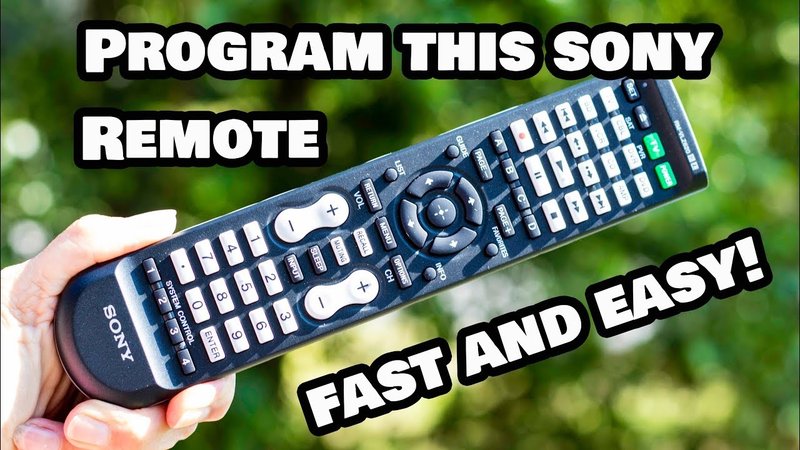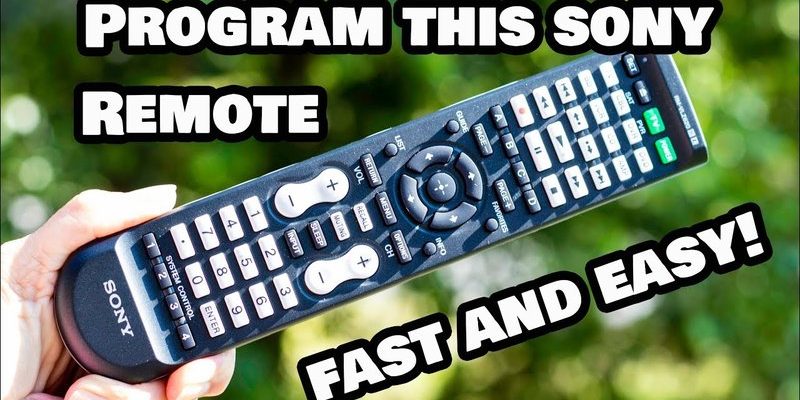
Here’s the gist: programming your Sony soundbar remote to control your TV isn’t rocket science, but it does involve a handful of specific steps that you might miss if you’re just winging it. I’ve been in your shoes, pressed every button, muttered a few choice words… and finally figured it out. So, grab your Sony remote, maybe a snack, and let me walk you through syncing it with your TV, so your living room feels a little less like a remote control battleground.
Understanding Sony Soundbar Remotes: The Basics
Let me explain what we’re dealing with here. Sony soundbars usually come with their own remote controls. These remotes look pretty sleek—minimal buttons, maybe a little intimidating if you’re used to old-school TV remotes with 50 functions. But here’s the thing: these remotes can sometimes *also* control your TV. Not every soundbar remote can do that, but the vast majority of mid-range and higher Sony models have this programmable feature built in.
Most Sony remotes use IR (infrared) signals, meaning you have to point them directly at the device for them to work. Occasionally, if you’re lucky, your setup might involve HDMI ARC or HDMI-CEC, and things will play nicely together with just a little nudge. But for many folks—especially if you bought your TV and soundbar separately—you’ll need to “teach” your Sony soundbar remote to communicate with your TV.
You might be wondering, “Why should I care?” Well, for starters, it’s about convenience. Imagine turning everything off with *one* button instead of hunting for three different remotes under the couch. Plus, you’ll feel like a home theater wizard once everything works in sync.
Gathering What You’ll Need
Before you start mashing buttons, a little bit of prep work goes a long way. Let’s keep things simple. Here’s what you need right next to you:
- Your Sony soundbar remote. Seems obvious, but some of us (me included) forget the basics sometimes.
- The TV remote. Sometimes you’ll need this handy for reference or to reset the process.
- Fresh batteries. Weak batteries are the silent culprit behind so many failed pairings. Just swap them out to avoid headaches.
- Your TV manual (or Google for your TV’s model number). Not always required, but it helps if you need to look up the brand code or a quirky setting.
If you’re the kind of person who likes to have all the ingredients ready before cooking, this is your moment.
Most importantly, get comfy near your TV and soundbar. The remotes need to “see” your devices, so make sure nothing is blocking the IR sensors (those little black dots on the front panels).
Finding the Right Remote Codes
Here’s where things get a little old-school—like tuning a radio or setting a digital clock. To program your Sony soundbar remote to your TV, you’ll often need a specific “remote code.” Think of it as a secret handshake your remote and TV share to communicate.
Brand codes are usually listed in the back of your Sony soundbar’s manual (yep, the paper one in the box) or available online. Most major TV brands—Sony, Samsung, LG, Panasonic, Toshiba, and so on—have their codes widely available. If you can’t find the exact code, try a quick search: “Sony soundbar remote code for [your TV brand].”
Here are some example TV brand codes for Sony remotes:
| TV Brand | Common Code |
| Sony | 01, 000, 002 |
| Samsung | 02, 003, 005 |
| LG | 04, 006, 009 |
| Panasonic | 08, 013 |
| Toshiba | 07, 015 |
Be patient—sometimes you have to try a few before one “clicks.” And if you’re stuck, Sony’s support page is surprisingly user-friendly for code lookups.
Step-By-Step: Programming The Sony Soundbar Remote
Now for the main event: syncing your Sony soundbar remote to your TV. I’ll break it down into clear, beginner-friendly steps.
- Step 1: Turn on your TV manually (just so you know it’s working).
- Step 2: On your Sony soundbar remote, look for a button labeled “TV,” “SYNC,” or “STB.” It varies by model, but this is usually your starting point.
- Step 3: Press and hold the “TV” button until a tiny LED light blinks or stays on. This tells you the remote is in programming mode.
- Step 4: Enter the TV brand code you found earlier. Use the number pad on your remote—nice and slow. If you mess up, there’s usually a way to restart by holding the “TV” button again.
- Step 5: Release the “TV” button and aim the remote at your TV. Try a simple command, like turning the TV off or changing the volume.
Here’s the real talk: Sometimes, the remote doesn’t respond on the first try. Don’t panic. Go back to step three and try another code for your TV brand. If you still don’t have luck, double-check you’re using fresh batteries and nothing is blocking the IR sensor.
Pro tip: Write down the code once you find the one that works. You’ll thank yourself later if you ever reset your system.
Common Problems And How To Troubleshoot
You might be wondering—what if things don’t go smoothly? (Because, honestly, tech never seems to work on the first try). Here are the most common hiccups and how to fix them.
Remote not responding? First, check the batteries. Seriously, even brand-new ones can be duds. Next, make sure nothing’s blocking the path between the remote and your devices—IR needs a clear view, or it gets grumpy.
Entered the code but nothing happens? Try another code for your TV brand. Some TVs have multiple code options, so don’t give up after one miss. Also confirm you followed the holding/releasing sequence for the “TV” or “SYNC” button. It sounds silly, but even missing a beat can throw things off.
Still having issues? Maybe there’s a compatibility gap. Some older Sony remotes just can’t pair with certain TV models, especially if the tech gap is more than a decade. In that case, you can try a universal remote, or use HDMI-CEC if your TV and soundbar support it (it lets devices talk to each other through the HDMI cable, like a secret language).
HDMI-CEC: The Slick Alternative If You’re Stuck
Let me tell you about HDMI-CEC—it’s like magic (when it works). HDMI-CEC (Consumer Electronics Control) lets your devices control each other through the HDMI cable. If you’ve got a newer TV and soundbar, chances are good this feature exists, but it’s often buried in the settings as something like “BRAVIA Sync,” “Anynet+,” or “Simplink.”
To use it, connect your soundbar and TV with an HDMI ARC cable (ARC stands for Audio Return Channel). Then, head into your TV settings and turn on HDMI-CEC. Sometimes, it’s as simple as flipping a switch labeled “Control other devices.”
What does this do? It means your TV remote can adjust soundbar volume and turn it on/off automatically. No extra codes, no awkward button-mashing. But—small catch—it doesn’t always let you use the soundbar remote for *all* TV functions, just the basics.
If the regular programming steps don’t work, think of HDMI-CEC as your “get out of jail free” card.
Resetting Your Sony Soundbar Remote
If you’ve tried everything and your remote is still throwing a tantrum, a reset might be in order. Sometimes remotes just get “stuck” in a weird state—like when your phone needs a reboot.
Resetting is usually as simple as:
- Remove the batteries from the Sony soundbar remote.
- Wait about 60 seconds (grab some water, stretch, whatever).
- Reinsert the batteries while holding down the “Power” or “TV” button (check your manual for the exact combo).
This wipes out any weird settings and brings the remote back to its default state. You’ll have to re-enter your TV code and re-sync, but sometimes, a fresh start is just what’s needed. I once spent half an hour troubleshooting before realizing a reset solved everything in two minutes—lesson learned.
Universal Remote vs. Sony Remote: Which One Is Better?
You might be quietly considering: should you just get a universal remote instead? There’s good reason to think about it. Universal remotes can control almost any device with the right code, including TVs, soundbars, DVD players, even your old VCR if you’re feeling retro.
But here’s the trade-off: Universal remotes are great if you own a bunch of different brands and want true “one remote to rule them all” power. However, Sony’s own remotes usually have the best button layouts for their soundbars, and their codes are typically up to date for Sony products. If you mostly use Sony gear, the original remote is usually the simplest option.
If you ever switch to a new TV brand or add more devices, then a universal remote might be worth the investment. Just make sure you get one with enough buttons for your needs—some budget models skimp on essential functions.
Think of it like this: Sony remote for simplicity, universal remote for flexibility.
Creating Your Own Remote Routine
Once your Sony soundbar remote is synced up with your TV, life gets simpler. You can turn everything on or off with just one remote, adjust the volume, and—most importantly—spend more time watching your favorite shows and less time hunting for lost remotes.
But here’s something a lot of people forget: *your* routine should match your setup. If you still need to switch inputs or want faster access to streaming apps, you might want to keep your TV remote nearby. Some folks even label their remotes or keep a cheat sheet on the coffee table with common codes and steps, just in case something gets out of sync after a power outage or battery swap.
The point is, once you get the hang of programming your Sony soundbar remote to your TV, don’t be afraid to tweak and personalize the system. Tech should bend to *your* life—not the other way around.
Bringing It All Together
Getting your Sony soundbar remote programmed to control your TV is a little like learning a new dance: awkward at first, but smooth and effortless once you get the moves down. With a bit of patience and these simple steps—plus maybe a reset here or there—you’ll get your whole entertainment setup working in sync. And hey, if you run into hiccups, you’re not alone. Everyone needs a little troubleshooting now and then.
So, next time your friend complains about their pile of remotes, you’ll have the perfect advice (and maybe a hint of smug satisfaction). Enjoy your streamlined setup—and more importantly, enjoy the show.
